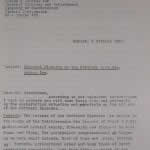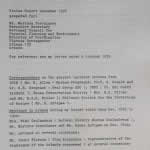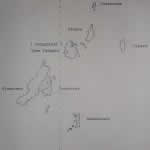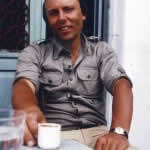Part one
The initiative proposal for the first marine conservation area in the Mediterranean Region is well documented by the respective correspondence and memos of the time: I am presenting here first page copies of the letters dated 6 October, 1976 (total 7 pages) and 23 December, 1976 (total again 7 pages plus 3 maps) . The reader should become aware that this proposal (with much follow up correspondence not published here) was fully representative and was adopted by the Greek authorites concerned – initially there existed no Ministry of Environment, but only the National Council for Physical Planning at the Ministry of Coordination. Actually the suggestions for physical planning as laid out in the proposal of 6 October 1976 (cf. text below) presented a wider framework than was ever considered in the procedures of implementing the conservation measures.
Much valuable support was extended by Mr. Byron Antipas, Honorary Secretary of the Hellenic Society for the Protection of Nature.
The first photographs and film shots of a male Mediterranean monk seal were taken in May 1976 at Piperi Island, thanks to the indispensable help of the Alonnisos (Wotsi) fishermen Giannis and Mitzos Florous (whom I first met in 1957), in conjunction with producing the TV documentary (ZDF German Television) Coast of the Monk Seals. This 45 min film reached a ratings of 36 %, that equals 11.8 million viewers at the first release, and was distributed thereafter to more than 10 other countries including Greece. The proposal for the marine conservation area Northern Sporades was in fact a side-line of this film documentation.
In 1992 a follow up film of 30 min was produced: Odyssey for a Seal, again for ZDF. An additional programme, also of 30 min length, was produced for ERT 1 (Greek) TV, as episode # 12 in the series Greece – a Treasure of Nature, in the early 1980s. This series was screened year after year until presently. It is now available online from Greek Television Archive. At the first monk seal conference 1978 on Rhodes (organiszed by Keith Ronald), the first monk seal film was shown to the participating scientists; most of them had never seen a monk seal before… So the focus of conservation turned from the Dodekanesos to the Northern Sporades. (cf. photographs above: the author with Kai Curry-Lindahl, UNEP at Rhodes 1978 — with Maurice Strong, secretary general of the Rio Earth Summit, on a cruise to Delos 1993 — and on Alonnisos 1976).
This pleasant and productive initial period has all been renounced since: In 1994 my application for a filming permission in the core zone of Piperi, on behalf of producer Heinz von Matthey of German television, was refused by the Ministry of Environment, with the „reason“ that there existed no management body yet to give such permission. My question in return, who then had granted authority to MOm for working in the core zone of Piperi, was not responded to by the Ministry… a clear indication for unlawful collaboration between the Ministry and MOm – being afraid perhaps that I might find out the truth about the seals „baby boom“ at Piperi and other dodgy success stories? Why should I be held off from returning to Piperi: In 1957 I discovered there a new sub-species of lizard (named after my travel companion Wilfried Weigend Podarcis erhardii weigandi). In December 1976 I chartered a helicopter and took Mrs. Niki Goulandris from Athens to Piperi in order to promote protection of this (in the capital) totally unknown natural juwel. And my earlier filming on Piperi had been instrumental in promoting the seal and habitat conservation programme. David Attenborough of the BBC (whom I assisted in Bristol as an adviser for the programme series The First Eden) was granted permission to film at Piperi without any administrative hurdles…
This campaign to elimit „the German“ from the forefront of seal research and protection accumulated in the claim by MOm that the park was established after their proposal (note: MOm was founded in 1988, 12 years after the detailed proposal as documented here was actually made). I feel obliged to respond to this perfidous twisting and suppression of a sincere beginning with partners who all were truly honest and motivated conservationists, by my determination that I shall refuse, at any occasion, to accept any award by the State or any Hellenic NGO for my merits in Greek nature protection – besides the Marine Park Northern Sporades I refer to the Rhodopi virgin forest reserve , the Gorge of Samaria (cf. the relevant articles) and the pioneering film series mentioned above that was achieved with a minimum budget and actually much personal investment in order to carry it through. Evidently, the Greek nation is not capable nor willing to share credits in a fair manner with foreigners: One Greek scientist pronounced it straight: “ Ο Θωμάς has done marvellous things for conservation in Greece. But there is one problem: He is not Greek.“ I have to thank the Almighty that I am not, under these despicable circumstances!
And looking back to the never ending struggle over five decades in this country I got to point out that I became involved not for any national reasoning, but for the benefit of the wonderful wildlife out there that only incidently resides on Greek soil or in Greek waters. Efficient nature conservation (and the preservation of rural culture) is almost non-existent in Greece nowadays, despite of all the millions allocated in good faith by other European states. So most of the achievements reached over one life time were either ignored or ended up in shambles.
After this rather depressing excurse, back to the enjoyable times when the Marine Park was first outlined. I am presenting here the full text of the first letter. The second letter, of 23 December, 1976 will be presented in a separate article: Northern Sporades conservation area – continued.
Dr. Thomas Schultze-Westrum Kaiserstr. 52 8000 München 40
Mr. Marinos Yeroulanos
Executive Secretary
National Council for
Physical Planning and Environment
Ministry of Coordiantion
Munich, 6 October 1976
Subject: Physical Planning on the Northern Sporades, Aegean Sea.
Dear Mr. Yeroulanos,
According to our telephone conversation I wish to provide you with some basic data and proposals on the conservation situation and potentials on the islands of the Northern Sporades.
General: The islands of the Northern Sporades are unique in the whole of the Mediterranean Sea because of their largely undisturbed natural beauty, diversity and richness in rare fauna and flora. The archipelago comprises about 40 larger up to very small islands. Most of them are green, covered by forests, agricultural areas and many types of lower vegatation communities. More than three quarters of the islands are uninhabited. Namely the outer islands, the so called „deserted islands“ provide an outstanding opportunity for physical planning and establishment of a conservation area with marine and island habitats.
Rare fauna like monk seal (Monachus monachus) and Eleonora falcon (Falco eleonorae) are still found in sound populations there.
Zoning: The large islands of Skiathos, Skopelos and Alonnisos have villages. Scattered agricultural settlements are also found on Peristeri.
Zone I comprises Skiathos and Skopelos with surrounding small islands. Their natural beauty (forests, agricultural lands, beaches) are famous and attract large numbers of tourists.
Physical planning on these islands concentrates on the establishment and maintenance of a balance between the tourist industry and conservation of landscape and traditional architecture.
Zone II comprises Alonnisos and Peristeri. Especially Alonnisos is (on its southwestern half) a very old agricultural area. This zone has significance in two ways: first it could become an island center for readoption and modernizing of old traditional practises which are in danger of being abandoned here and elsewhere and might have great sigificance again in future times (in co-operation with FAO and UNEP). Topics are breeding of the almost extinct endemic cattle which is suited to replace domestic goats, and the very great variety of crop cultivation according to traditional methods. Nowadays most of the fertile agricultural land is abandoned (mainly because most of the endemic vines with blue grapes were killed by a disease about a decade ago). Alonnisos and Peristeri would be very well suited also for experimental developing of modern agricultural techniques, crops and breeds of domestic animals along ecological principles for island habitats in Greece.
The second sigificance of this zone would be that of a buffer between zone I and zone III:
Zone III comprises the outer large islands Kyra Panagia, Gioura, the middle sized islands Piperi, Skantzoura and Psathoura and the small islands Gamsa, Papou, Strongyli (between Kyra Panagia and Gioura), Agios Petros and Melissa (near Kyra Panagia), Koraka, Skandili, Strongyli, Polemika, Kassidis near Skantzoura and Mikropsathoura (Muia) near Psathoura.
Habitation in this zone is limited to 1 – 2 families on Psathoura (light house), Kyra Panagia (monastery with one resident) and Gioura (2 families – wardens).
This island group and the surrounding waters are very well suited to become the most important conservation area in the eastern Mediterranean. The situation is unique, because a large number of almost undisturbed islands with surrounding very clean marine habitat is almost uninhabited and provides opportunities to protect a great variety of island and and marine ecosystems and rare species like the monk seal and several birds. I was very impressed by the great number of sea birds in the area which did not vary much from observations 19 years ago when I visited these islands for the first time.
Major interferences are goat grazing, shooting of sea birds and seals and egg collecting, underwater harpoon fishing by tourists.
Ownership for the islands is as follows: Gioura is state property because it is inhabited by a population of the very interesting feral goats (see below). Piperi is owned by one family in Skopelos ( K. Thomas Lemonis). Psathoura and Mikropsathoura are owned by several families. All the other islands are owned by the monastery of Lavra, Agion Oros. Acquisition of the islands would be no great problem, because the economic significance of the islands is very little. For Lavra it becomes more and more difficult to find shepherds for the herd of domestic goats on Kyra Panagia (about 1.500 heads!), and Mr. Lemonis has similar problems with the very distant island of Piperi, where formerly resin from several thousand pine trees was collected and about 500 goats were kept.
The fishing grounds around these outer islands are very good and supply mainly the local fishermen of Alonnisos and Skopelos (40 boats for Alonnisos and about 12 for Skopelos).
In this zone III the islands of Piperi and Gioura should be declared strict nature reserves (on Gioura already in force — for Piperi strongly recommended).
Piperi is to my opinion the most undisturbed middle sized inland in the Aegean! Its magnificent rock cliffs are inhabited by great numbers of Eleonora falcons and many sea birds in colonies. Along its rocky shores and small gravel beaches and in marine caves is still found a good population of monk seals (Monachus monachus). I observed (and filmed) 5 adults and three pups. The total population in zone III is estimated at about 40 specimens! The isolated position of Piperi is ideal for the conservation project. Additionally, Piperi provides the most beautiful natural scenery with large forests of pine and other plant communities.
I am hesitating to use the term „national park“ for this zone, because traditional utilization by the local (not other) fishermen could carry on. Domestic goats however, have to be eradicated and the feral population of goats on Gioura reduced to about 20% of the present density. Otherwise the oak forets and other vegetation cover on Gioura will suffer very badly and erosion rapidly increase. Both on Kyra Panagia and on Piperi free ranging herds of domestic cattle (endemic breed) could be kept (as gene pools for breeding) and other experimental projects along ecological lines which do not interfere with the conservation scheme. Also tourism will be a factor in zone III (except of Gioura and Piperi).
Wardens should be based also on Piperi and mobile patrols (boats) cover the whole area.
Sport hunting: I was informed about plans to create on Alonnisos a center for sport hunting for Greek residents and foreigners. Naturally, such project which includes also the introduction of foreign species of game is in opposition to the project lined out above. Not only that the attempt is great for hunters to enter also zone III for hunting. More serious is the disturbance by shooting: new investigations in Germany have revealed that a shot is not only a shock for the hunted species but a destructive factor also for other (especially bird) species during breeding and on migration. The islands of the Northern Sporades are a very important resting place for migratory birds. The large colonies of Eleonora falcons depend greatly on this supply of prey during their breeding season (end of August and September!). Herons and other larger species are frequently seen in the area. Certainly, nature tourism (wildlife, natural landscapes) will enormously increase on the islands. But these visitors are almost entirely non – hunters and would be scared away by intense hunting on Alonnisos. So tourism on the islands would suffer. Discovering the natural diversity and wilderness areas of Greece is a new aspect in developing tourism in Greece (combined with the evaluation of rural architecture like old style villages etc.). A hunters paradise on Alonnisos, right at the edge of the projected conservation zone III is absolutely impossible. Other islands like Skyros are much better suited for this purpose.
Protection of Monachus monachus: The monk seal finds on Piperi and to a lesser degree also along other island shores of the northern Sporades perhaps its most important refuge in the Mediterranean. I know of the existence of the species there for almost twenty years and I have sent reports to IUCN. In none of the recent surveys, however, this area is mentioned. The many caves and small beaches along the shores of Piperi are an ideal habitat for the species. Also there is a very good supply of fish, because the waters around Piperi are the best fishing grounds. Naturally, the fishermen of Alonnisos are shooting every seal they can get, because the animals destroy their nets and eat fish out of the nets. Due to personal contacts with Mr. Joannis Florous, speaker of the fishery co-op of Alonnisos I was able to keep the fishermen away from further shooting for a while until a long term regulation will be worked out between the fishermen and the Greek government. Laws without arrangements to satisfy the fishermen would be a catastrophy: If, for instance Monachus will be declared a protected species and Piperi a strict nature reserve, without that the interests of the local population will be respected, within one year – I am deadly shure – the whole seal population would be completely eradicated! Control is almost impossible to prevent this. It is essential to come, through careful negotiations, to a satisfactory agreement with the local residents first, before the law will be issued. Recompensation payments for nets are no solution. Better would be a provision of a number of nets at the beginning of each year together with payment in advance for the fish lost per year in average plus a small amount as an additional attractive. The fishermen must get the feeling that the seals bring them some advantage. Otherwise there is no future for the survival of this most important colony.
Traditional architecture: Integrated into the conservation and planning schemes for the Northern Sporades traditional villages like on Alonnisos (old site on top of the island) and on Skopelos need special attention and careful planning for modern houses and restoration of the old ones partly destroyed during the earthquake some years ago. Especially Alonnisos village, in context with the revival of traditional agricultural patterns would be very suited. Strict regulations for the building of modern houses and the use of modern materials like concrete are urgently needed. The restoration of the monastery on Kyra Panagia is not urgent, because still the buildings are in good shape. Unfortunately, most of the old icons have been taken from small and unlocked curches.
These are in rough outline some points for consideration. Naturally, the working out of a detailed master plan for the archipelago is a delicate and much more complex matter. I would be glad if the Greek Government and Your Council in particular considered the project. The Marine Programe of IUNC (see enclosed copies) would be a good opportunity to link up with international efforts to safeguard marine and island habitats. My personal assistance will be available at any time.
Yours very sincerely,
Th. Schultze-Westrum
cc: Mrs. Niki Goulandris
Mr. Byron Antipas
The Marine Programme Officer, IUCN
Dr. Hartmut Jungius, WWF
Dr. D.E. Sergeant, Chairman of Seal Group, IUCN
Mrs. Maisie Fitter, Fauna and Flora Preservation Society
Dr. Kai Curry – Lindahl, UNEP
See more in the article Northern Sporades conservation area – continued
(letter of 23 December, 1976 and further documentation)





